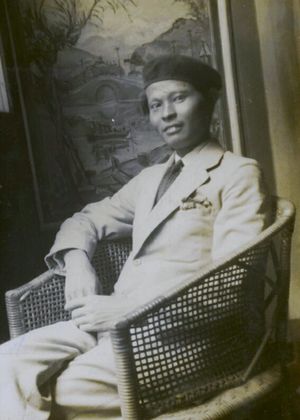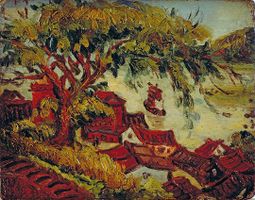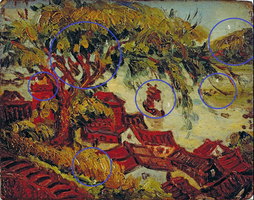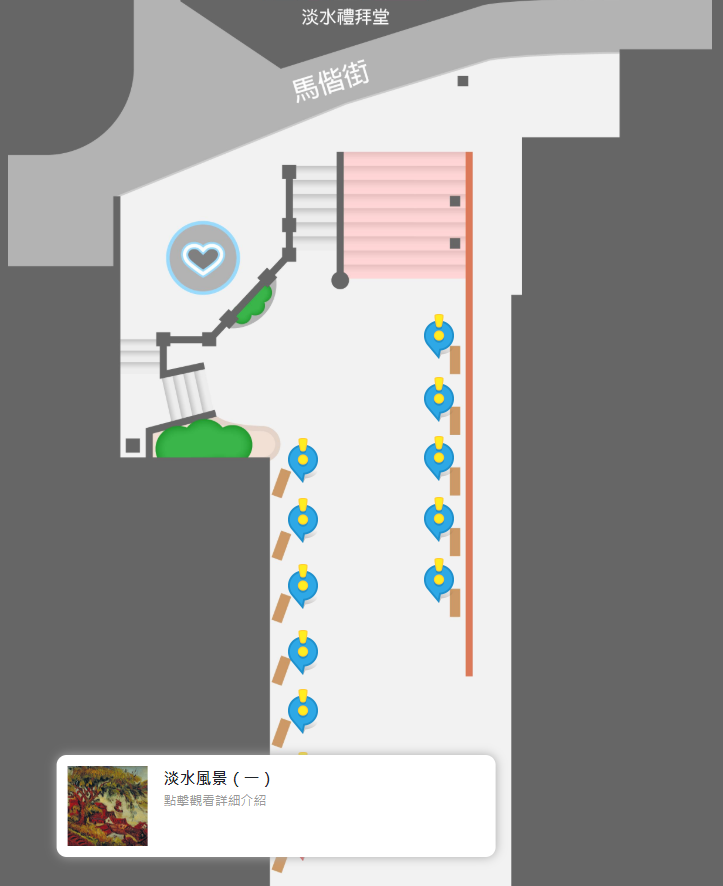陳澄波在淡水
簡介
陳澄波生於1895年的臺灣嘉義。1924年3月考入東京美術學校圖畫師範科,並在三年級時(1926年),以油畫作品〈嘉義街外(一)〉入選帝國美術展覽會,成為臺籍畫家中的第一人。
1927年,再入同校師範科當研究生。1929年畢業後,即前往上海任教,除和藝壇人士密切交往外,在個人的創作上,也展開了極具實驗性質的多方嘗試,包括「中西融和」的畫法和「前衛思潮」的探索。
1933年,陳澄波返回臺灣定居,次年,便結合全島畫友組成「臺陽美術協會」,成為迄今仍然活躍的全臺最大民間美術團體。而在創作上,也拋棄一切束縛,盡情地發揮自我的熱情,為故鄉留下大批動人的畫作。
1945年,二次大戰結束,國民政府接收臺灣,陳澄波積極宣導美術,並計畫籌建美術學校。1947年受228事件牽連而罹難,享年53歲。
Chen Cheng-po was born on 1895 in Chiayi, Taiwan. In March 1924, he was admitted into the Art Teacher Training Department of the Tokyo School of Fine Arts. During the third year of his studies (1926), his oil painting Outside Chiayi Street (1) was selected for the Imperial Fine Arts Academy Exhibition. Chen was the first Taiwanese painter to have obtained such an honor.
In 1927, he continued to pursue his studies at the Teacher Training Department of the Tokyo School of Fine Arts. Upon his graduation in 1929, Chen Cheng-po went straight to Shanghai to take up a teaching post. Apart from his close association with art circles, he also experimented extensively in his own creative process. This included the integration of Chinese and Western painting skills and the exploration of avant-garde trends.
In 1933, he returned to settle down in Taiwan from Shanghai. In 1934, he founded the Tai Yang Art Exhibition with a group of painting enthusiasts from all over the island. The exhibition was the largest non-official art organization in Taiwan and one that has remained active to this day. During this period, Chen had freed himself from all restraints and expressed his inner passions without reserve in his works, a legacy of painting masterpieces of his homeland.
In 1945, the World War Ⅱ came to an end and Taiwan was returned to the Nationalist Government. He was actively involved in promoting art and planned to establish an art school. Chen Cheng-po was only 53 years old when the 228 Incident in 1947 claimed his life.
作品
淡水風景(一) 1935 木板油彩 19×24cm
站在禮拜堂後方的小山坡上,陳澄波眼裡的小鎮風景,呈現一種和諧的反差──天空與河水清淺如碧,屋瓦、磚牆、樹幹與帆船卻醞釀著深沉的紅。 淡水特有的潮濕空氣蒸騰在畫境裡,岸上景物的粗獷線條似也隱隱躁動。但遠方山水寂然無聲,河上慢船投射出寧靜倒影。 樹梢的輕曳隱喻了一陣和風,消融了紅與綠、動與靜的衝突,調和出獨特的美感。
- 1. 樹
頭角崢嶸的一株闊葉樹搶佔近景,它的枝幹恣意蔓生,環繞在樹旁的低矮植物也躍然有動勢。 油彩在樹冠上皴擦出大片青綠,在水天一色的烘托下,綻放出旺盛的生命力。畫筆輕掠,帶出右側樹梢的晃影,暗示了微風的撫觸。
- 2. 景物線條
與陳澄波的其他淡水主題作品相比,這幅小型的木板畫有較繁複的擦筆,油彩也相對厚重。 自上海返臺的陳澄波受中國水墨畫的衝擊,或也影響他對這幅畫的構思,著意於表現景物線條的動態。
- 3. 帆船
一艘單桅帆船在水面上徐徐航行。古舊的中式帆船,可以投入內河運輸、遠洋航行、近岸捕魚等各種用途,在數百年前便已航行於淡水河口。 畫家特意將帆船與岸上建築安排為同樣的磚紅色系,或也暗喻著同樣厚重的歷史沉積。
- 4. 沙洲
水面上的淺綠色塊是覆蓋著綠色植物的沙洲。臺灣文學家王昶雄在《淡水河的漣漪》裡寫到「河面靜靜橫著的綠色中洲」, 以及粼粼水波、繽紛街景,像是「夢的殿堂裡少女雲裳天成的色彩」──那是否也是陳澄波心裡的顏色呢?
- 5. 觀音山
觀音山的南麓被帶進了畫面右側的遠景。在濕氣的浸潤與暖陽的照拂當中,河對岸的山坡上,也表現出溫潤的黃綠。 澄亮而溫暖的顏色連接著近景的樹冠,大自然的生機也在遠近之間,宛轉流動。
6. 淡水禮拜堂 淡水禮拜堂的鐘塔在大樹背後隱隱浮現輪廓。在畫家的感受裡,聳立於小鎮當中的仿哥德式建築尖塔,似乎並不令他覺得突兀。 洋樓的磚紅,反倒與周遭閩式建築群的磚瓦顏色,融溶為和諧的整體。
相關影片
- 影片描述:《畫我台灣》陳澄波的淡水印象
- 影片來源:YouTube




